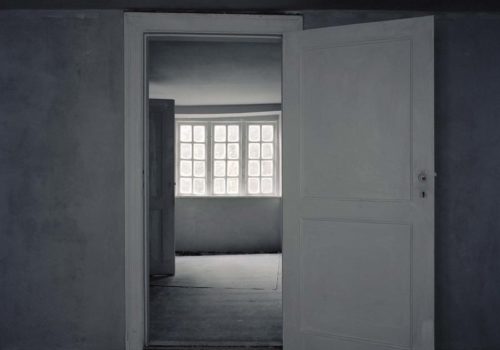Martin Asbaek (Copenhagen) presents works by Trine Søndergaard (DK) and Martin Liebscher (DE).
The artistic idiom of the presentation of the two artists is enigmatic and timeless like a Nordic fairytale, whose narrative unfolds as the viewer is absorbed by the theaters overwhelming interiors and the girls back and neck with the embroidery hat.
The photos are still – the second before the play begins, the empty rooms with dusted floors and open windows, and the young girls, who just turned their back to the viewer.
The series of portraits named Guldnakke (Goldennecks) shows young teenage girls wearing gold embroidery hats form the nineteenth century and their own modern clothes. The encounter between the soft skin of the girls’ necks and the metal threads of the embroideries underscores this union of opposing qualities.
The in between and timeless space is also found in the series Interior. The works are harmonious and slightly melancholic in grey-shaded scales with a keen awareness of the rendering of the Nordic light. Interior is able to recreate this masterly use of the natural light by using long exposures, so that the light in the works becomes almost magical. The photographs offer deep perspectives with rooms en suite, worn-out dismantled doors, empty rooms with soot-stained walls and open, ramshackle windows through which stark light streams in onto the dusty floors of the abandoned Oreby Castle. Martin Liebscher brings a slightly humorous twist to the presentation, which is rather still. The work of the Royal Theater explores the familiar way of acting in a theater. The works of Martin Liebscher are produced by digitally processing scanned photographs that Liebscher takes of himself with an automatic shutter release. The figures are not digitally manipulated. They are images of a real person in action – in this case Volksbühne in Berlin, Germany. In his Family Pictures Liebscher always works on the basis of a specific architecture or social environment, and the titles of his works are simply the names of the sites he invades as omnipresent protagonist.
The interior of the theatre is like stepping into the past, but with a present element of the modern clothes the artist is wearing just like the girls in the series Guldnakke. Various states, times and materials co-exist in all the works, which create a kind of third space that is neither past nor present, fact nor fiction.
















